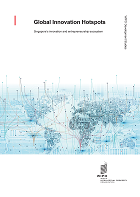Innovation Hotspots: The Singaporean Recipe for Development
Singapore’s policymakers have played a significant role in helping the state transition into a high-income economy in less than forty years. Learn about which policies proved to be the most effective!

Singapore’s innovation policies over the last 30 years have allowed the country to develop its own technologies and become a high-income economy. Such policies aim to ensure the symbiotic relation between large innovative enterprises, entrepreneurs, and venture investors.
These policies can be summarized into 2 categories:
- Supply-push innovation policies. These intend to build the infrastructure and make investments that stimulate innovations.
- Demand-pull innovation policies. These tend to facilitate the adoption of new products and services to mitigate the risk of developing them.

Building the Supply
The Singaporean government has played an active role in building its supply-side innovation capacity. Over the past four decades, Singapore invested the financial, physical and human capitals necessary for its economic transition into an innovation leader in the region.
To compensate for the dropped of the share of private local funding from one third to one quarter between 2005 and 2015, the government provided a US$1 billion in public funds to revive the venture capital industry. This initial substantial public investment has been continued since. Key public spending in critical infrastructures such as to build its smart city infrastructure and healthcare contributed to the growth of innovative activities of indigenous start-ups. In addition, public investments into education, and research and development contributed to its strong reputation in the regional and international research, with two universities ranking as first and second in Asia in 2019 and 2020. Moreover, the quantity and quality of its fundamental research are notably enhanced by the intensification of entrepreneurship training and spin-off incubation. It is thus not surprising that the Singaporean public research institutions (PRIs), universities and start-ups demonstrate the sharpest growth in patent application over the last 20 years.
Providing the Demand
The government has also been instrumental in providing the demand for Singaporean-led new technological innovations. In this regard, the government is an early adopter of relatively unproven new technologies or novel forms of services in sectors such as mobility, energy and more recently public healthcare during the COVID crisis. Because of this, several inventions became viable commercial innovations that has broadly diffused to the private sector.
Supporting Entrepeneurs
Finally, one crucial element of the Singaporean public policies is its innovation-friendly environment. Local innovators are able to rely on the support of specialized institutions to scale-up their start-ups. These services encourage commercial efforts by making it easier for the entrepreneurs to understand matters related to intellectual property protection, venture capital investment, mergers and acquisitions or initial public offering.
Other stories you may enjoy

The Importance of Making Connections
Just as people benefit from making connections in social and working environments, hotspots cross international borders to seek partners for innovation. Making these connections and choosing the right partners is increasingly important.

How Policy may Redirect Innovation
Government policies can affect the rate and, to some extent, the direction of innovative activities. Some of these policies, such as R&D tax incentives, protection of IP rights, encourage innovation.

